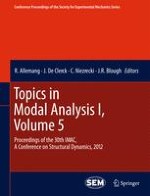2012 | OriginalPaper | Buchkapitel
18. Updated Cepstral Methods for Operational Modal Analysis
verfasst von : Robert B. Randall
Erschienen in: Topics in Modal Analysis I, Volume 5
Verlag: Springer New York
Aktivieren Sie unsere intelligente Suche, um passende Fachinhalte oder Patente zu finden.
Wählen Sie Textabschnitte aus um mit Künstlicher Intelligenz passenden Patente zu finden. powered by
Markieren Sie Textabschnitte, um KI-gestützt weitere passende Inhalte zu finden. powered by
